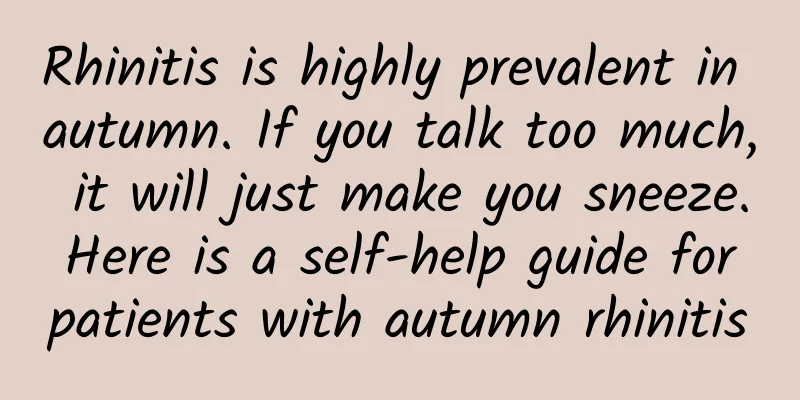Rhinitis is highly prevalent in autumn. If you talk too much, it will just make you sneeze. Here is a self-help guide for patients with autumn rhinitis

|
In autumn, the temperature difference is large, the weather is dry, and the dust mites and pollen in the air increase, which can easily lead to rhinitis. When rhinitis occurs, patients often have long-term runny nose and sneezing, which seriously affects their daily study and life. So, how can patients with rhinitis spend the autumn smoothly? Rhinitis is an inflammation of the nasal mucosa caused by viruses, bacteria, allergens, various physical and chemical factors, and certain systemic diseases. Rhinitis is divided into allergic rhinitis and non-allergic rhinitis. Allergic rhinitis is usually caused by allergens, and the severity of symptoms fluctuates with the seasons. Once patients with allergic rhinitis come into contact with allergens, they will develop symptoms of allergic rhinitis. There are many causes of non-allergic rhinitis, which usually exist all year round, including atrophic rhinitis, drug-induced rhinitis, senile rhinitis, etc. The main symptoms of rhinitis are nasal itching, sneezing, runny nose and nasal congestion, etc. The symptoms of sneezing and runny nose are most severe in the morning after waking up. Both allergic rhinitis and non-allergic rhinitis patients will experience nasal congestion, sneezing and runny nose, but allergic rhinitis patients often have itchy eyes or skin due to allergies, while non-allergic rhinitis patients often do not have this symptom. For patients with allergic rhinitis, staying away from allergens is an effective way to prevent the onset of rhinitis. The most common allergen is pollen. Pollen allergy has obvious seasonality and often occurs in spring and autumn. Indoor allergens often include dust mites, animal hair, fungi, cotton wool, and some food allergens. In addition, there are some unknown factors that can also induce allergies, such as temperature changes and endocrine disorders. If you find that you have allergic symptoms, you can first go to the hospital for an allergen skin test and serum-specific test to identify the allergens, and then be careful to stay away from things or foods that make you allergic. Patients who are allergic to dust and dust mites should keep their living environment clean and dry, ventilate well, and wash and dry quilts and clothes regularly [1]. In autumn, the outdoor temperature is low. Patients with rhinitis should pay attention to reducing the irritation of the nasal cavity caused by cold and dryness. Wear a mask when going out and try to avoid going to public places. Maintain the humidity of the indoor air to prevent the nose from being too dry. Also, open the window frequently for ventilation. Smokers with rhinitis should pay attention to quitting smoking in time, and non-smokers should also pay attention to staying away from second-hand and third-hand smoke [2]. Patients with allergic rhinitis can also clean their nasal cavity appropriately, using saline or some special nasal wash solution to clean the nasal cavity and sinuses, wash away harmful substances such as dust, bacteria, viruses, and some secretions, protect the nasal mucosa, and promote the restoration of the natural swinging function of nasal cilia. Do not pick your nose with your hands at ordinary times, as it can easily damage the nasal mucosa and cause bleeding or inflammation [2]. When rhinitis patients first start to experience symptoms, they may easily think that they have a common autumn and winter cold. When they find that symptoms such as nasal congestion, runny nose, and sneezing do not disappear for a long time, they should be alert to whether it is rhinitis. Do not underestimate this minor disease. If rhinitis is not treated for a long time, it will cause a series of complications. Rhinitis patients should seek medical treatment in time, find the cause of their disease in time, actively treat it, and take good protection and care in daily life. Patients with rhinitis should pay attention to eating more fruits and vegetables, quit smoking and limit alcohol, avoid spicy food, and drink more boiled water. They can also do proper exercise, which can enhance people's resistance and help relieve allergic symptoms. Before exercise, pay attention to warming up to allow the body to gradually adapt to the temperature and humidity of the exercise environment to avoid irritation to the nasal cavity. 1. Chen Peiyi: Prevention and treatment strategies for allergic rhinitis in autumn. Food and Health 2014(10):40-41. 2. Chen Baoli: Prevention and nursing experience of allergic rhinitis. Journal of Qiqihar Medical College 2011(17):2873-2874. |
<<: A different kind of edema - hereditary angioedema
>>: What is ants climbing trees? What are the characteristics of ants climbing trees?
Recommend
What are the methods for women's reproductive health and health care?
I believe that many married women will have this ...
What are the causes of breast ductal tumors?
Breast duct adenocarcinoma is actually a relative...
What are the common symptoms of gynecological inflammation
Gynecological inflammation refers to various dise...
Insider Intelligence: TikTok is expected to become the world's third largest social networking platform in 2022
A new forecast claims that TikTok will become the...
[Medical Q&A] Are tinea corporis and eczema the same thing?
Planner: Chinese Medical Association Reviewer: Pr...
How should dysmenorrhea be treated?
Many women will experience some dysmenorrhea. Dys...
What to do if cracks appear on the wall after one year of renovation? Method of applying latex paint on putty wall
The paint in my home has cracked after one year o...
How to relieve chest tightness in pregnant women
During pregnancy, pregnant women not only experie...
Breast health tips
Preventing breast diseases is something every adu...
How were the Egyptian pyramids built? Which continent does Egypt belong to?
Egypt is a country in northeastern Africa. It is ...
How to see what comes out of the drug abortion
If you want to get rid of an unwanted pregnancy, ...
Can you have sex with a condom before medical abortion?
Not all pregnant women who want to have an aborti...
The accident happened after only 1 ml of local anesthetic was injected. Pay attention to this detail!
In clinical practice, we know that a few millilit...
How long does it usually take to treat chronic pelvic inflammatory disease?
Pelvic inflammatory disease is an inflammation of...









